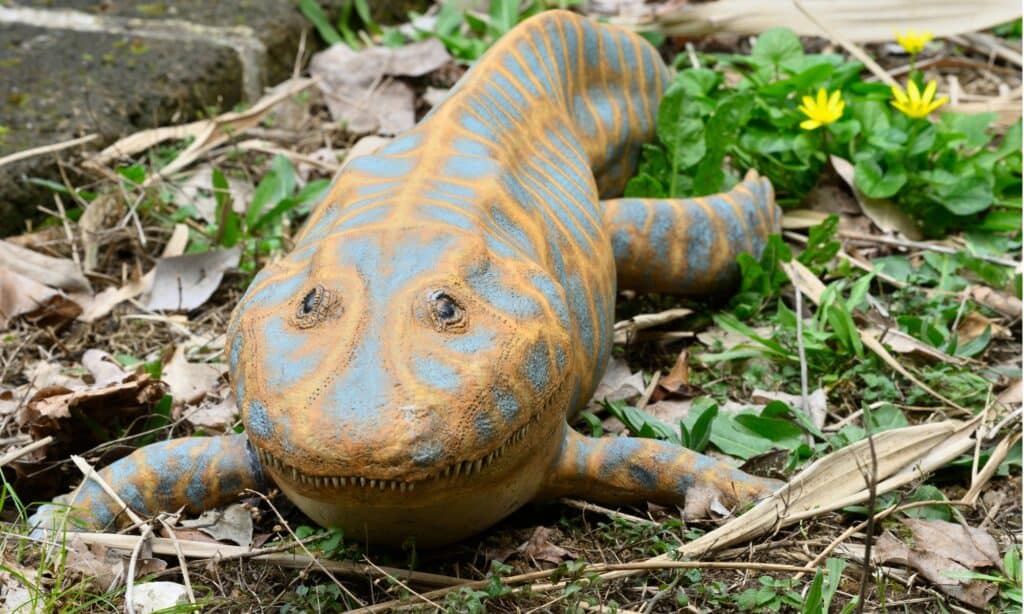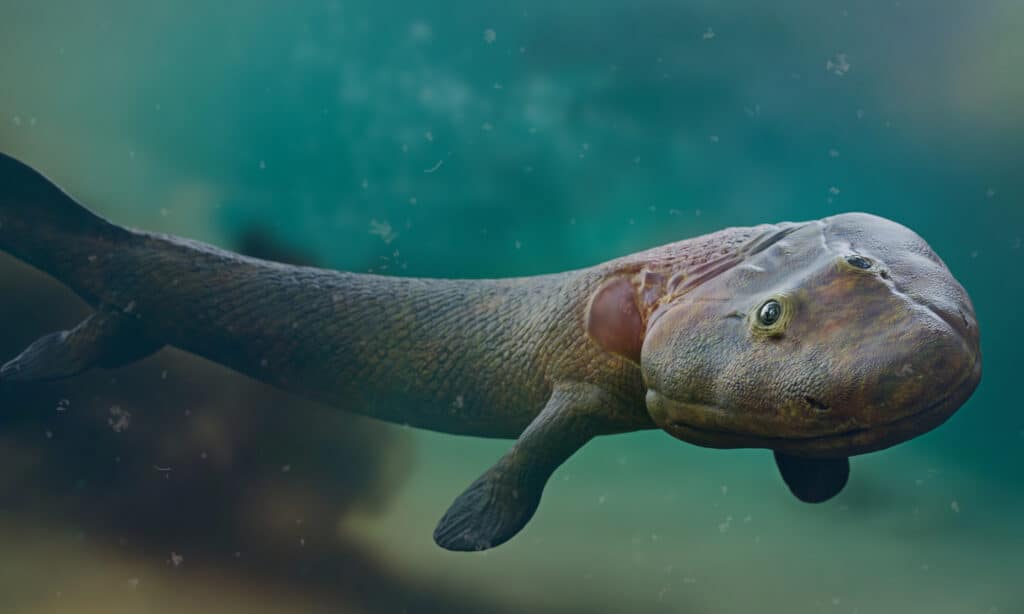The Devonian Period was a geographic period of the Paleozoic Era that occurred from 419.2 million to 358.9 million years ago. It was the fourth period of the Paleozoic, preceded by the Silurian and followed by the Carboniferous. The name “Devonian” was coined by the English geologist Adam Sedgwick and the Scottish geologist Roderick Murchison in 1839 for the marine rocks they encountered in Devon, England. This period is also known as the “age of fishes” because of the diverse, abundant, and strange-looking creatures that evolved in the Devonian seas. Away from the sea, a few incredible Devonian Period animals also ventured on land.
At the dawn of the Devonian, the appearance, geography, and climate of the planet were transforming. The Gondwana supercontinent was steadily heading northward, away from the South Pole, and another supercontinent began to form. The Devonian Period was undoubtedly a significant time in Earth’s geologic history. It ushered in the beginning of proper life (both flora and fauna) on land.
The climate change during this period paved the way for the evolution that changed the earth. The climate was warmer than what we have in the present day. As free-sporing vascular plants began to spread to dry land and several groups of plants evolved into trees, the animals evolved as well. The following are some of the most incredible animals that lived during the Devonian Period.
Devonian Period Animal 1: Ptyctodontids
The ptyctodontid belonged to a group of marine creatures known as the placoderms. Members of this group are known for their body armor formed by bony plates. Although placoderms evolved in the Silurian, the Devonian saw their major period of dominance. This particular group of placoderms was different from others. They had big heads and eyes, with significantly reduced armor.
The Ptyctodontidae fish family lived 380 million years ago during the Late Devonian. They were similar to modern-day chimaeras in their appearance. The ptyctodontids were among the most primitive placoderm that ever lived. It was the only placoderm to be sexually dimorphic. Male ptyctodontids had hook-like growth on their pelvic fins, similar to the clasping organ found in male sharks and chimaeras. This creature is said to have lived near the bottom of the sea and fed on shellfish.
Devonian Period Animal 2: Dunkleosteus
The Devonian seas also saw one of the earliest apex predators in nature. Dunkleosteus is an extinct jawed fish that existed around 382–358 million years ago. It was a placoderm, which means it was also an armored fish. But arguably the most interesting attribute of this Devonian fish was the nature of its dentition. Dunkleosteus had sharp, self-sharpening bony plates instead of teeth. This formed a beak-like structure that could potentially cut through the armored exterior of many shelled Devonian Period creatures and other armored fish.
Up to 10 species of Dunkleosteus have been found to date. Dunkleosteus terrelli was this group’s largest and most well-known species, attaining lengths of up to 29 feet. Despite being built to catch prey, Dunkleosteus might have been a slow swimmer. Scientists think the two-part bony armor of this fish is to blame for this. Additionally, experts believe the Dunkleosteus was one of the earliest vertebrates to internalize egg fertilization, as seen in some present-day sharks.

had self-sharpening bony plates instead of teeth.
©Esteban De Armas/Shutterstock.com
Devonian Period Animal 3: Ichthyostega
Towards the end of the Devonian, aquatic animals began to venture on land. Ichthyostega was one of the first true land-living vertebrates that lived 370 million years ago. Members of this genus were among the first animals to develop a limb structure that could bear their weight on land.
The Ichthyostega is fascinating because it combines features of various prehistoric animal groups. This creature had limbs and fingers like those of tetrapods. However, it is not a true “tetrapod.” Also, it had an amphibian build and lived in swamps and shallow water. It was not a true member of that group either. Because of these attributes, Ichthyostega is often considered a transitional animal between fish and tetrapods.
Ichthyostega was a relatively large, 4.9-foot-long animal that may have had lungs for breathing on land. Its skull was low, and it had dorsally placed eyes with large teeth. Although it had feet rather than fins and could pull itself out of the water, this animal would have struggled on land. It moved like a seal or mudskipper, even though it was built like a salamander.

is often considered a transitional animal between fish and tetrapods.
©iStock.com/AlessandroZocc
Devonian Period Animal 4: Proetida
The trilobites appeared in the Early Cambrian Period (521 million years ago), dominating the Cambrian and Early Ordovician seas. They were among the earliest-known arthropods ever discovered. Fossils of this marine arthropod are quite abundant in the Early Paleozoic seas. However, by the time the Devonian Period began, the group was starting to experience a decline. The Proetida is the only trilobite order that survived beyond the Devonian. They were the last group of trilobites to go extinct and one of the most incredible Devonian Period animals.
Proetids were typically small trilobites, but they still looked similar to other trilobites in terms of their general body configuration. They had a segmented exoskeleton with eight to 22 segments on their thorax. They were known to possess intricate eyes with up to 15,000 lenses in each eye.
Devonian Period Animal 5: Tiktaalik
Although the Tiktaalik is a genus of lobe-finned fish, it had many features similar to that of the tetrapods. Because of this, many scientists consider this Late Devonian genus one of the earliest primitive tetrapods.
The Tiktaalik had scales and gills like other bony-fish species. However, it had an unusually flattened head and cleaver-shaped fins. Although the fins were primarily for swimming, they had interior bones. This would have made it possible for the Tiktaalik to prop itself up in shallow waters using its limbs for support like a tetrapod. In essence, the Tiktaalik lived and moved like a typical lobe-finned fish, but its skeleton was closer to that of a crocodile.

Tiktaalik had an unusually flattened head and cleaver-shaped fins.
©Dotted Yeti/Shutterstock.com
Devonian Period Animal 6: Adelophthalmus
Eurypterids (also known as sea scorpions) are arthropods that evolved as early as the Ordovician Period. The earliest eurypterids were marine animals, but later forms lived in fresh or brackish water. The group was the major highlight of the marine ecosystem during the Silurian Period. A number of them survived into the Devonian, becoming some of the most incredible animals of that period as well.
Adelophthalmus was the longest-living sea scorpion. They were around for more than 120 million years, from the Early Devonian to the Permian. Adelophthalmus was among the last surviving members of the eurypterid group. It was also the only genus of swimming eurypterids that lived in the Devonian, with all the others being bottom crawlers. This comparatively small sea scorpion was probably blind, and its name is a reference to an apparent lack of eyes. The largest species in the Adelophthalmus species was about 12 inches in length.
Up Next
- Devonian Period: Facts, Information, and Timeline
- Discover the Ancient ‘Fishapod’ That Could Walk on Land
- Discover 5 Incredible Silurian Period Animals
The photo featured at the top of this post is © Esteban De Armas/Shutterstock.com
Sources
- Wikipedia, Available here: https://en.m.wikipedia.org/wiki/Devonian
- Britannica, Available here: https://www.britannica.com/science/Devonian-Period/Devonian-life
- Live Science, Available here: https://www.livescience.com/43596-devonian-period.html
Thank you for reading! Have some feedback for us? Contact the AZ Animals editorial team.






